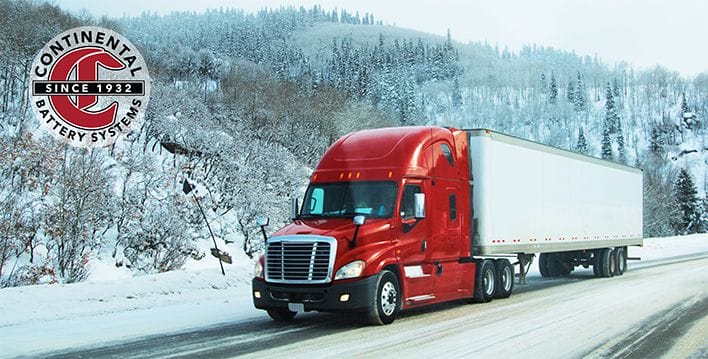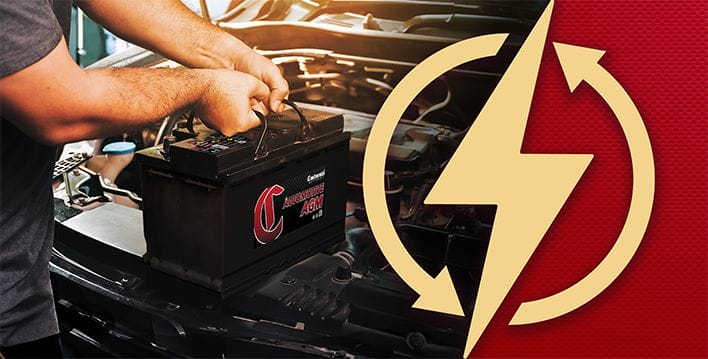
Commerce doesn’t stop when the weather turns cold, but winter weather can wreak havoc on freight networks and the trucks that keep them moving. In addition to weather-related accidents due to hazardous driving conditions, extreme cold can strain vehicle systems, reducing efficiency and increasing wear on critical components.
One of the most overlooked culprits is the impact of freezing temperatures on batteries, which can lead to expensive downtime if not properly managed.
Ensuring your fleet’s batteries are in top condition can make the difference between seamless operations and costly delays. In this post, we’ll share tips to keep your batteries performing at their best during the colder months.
How Cold Weather Affects Your Fleet’s Batteries
When temperatures dip below freezing, the chemical reactions inside the batteries become less efficient. The movement of ions within the electrolyte slows down, reducing the battery’s overall ability to deliver current.
This general slowing down can impact commercial truck batteries in several key ways:
Reduced capacity. Extremely cold temperatures slow down the chemical reaction inside the batteries. At 0 degrees Fahrenheit, a battery with a full charge has less than half its potential starting power.
Increased strain. In extreme cold, the engine oil in your trucks becomes thicker and slower and requires more power to start the engine, putting additional strain on the battery.
Reduced efficiency. Between 0 and 10 degrees Fahrenheit, your battery performs at about 50% efficiency.
Higher failure risk. If your battery was weak or at the end of its lifespan before, cold weather can expose or exacerbate issues.
Freezing risk. Commercial truck batteries are designed to operate at extremely low temperatures (down to -58 degrees Fahrenheit in some cases), but if your battery is not fully charged, it could freeze as soon as the mercury drops below 32. Freezing electrolyte can significantly and permanently damage your battery.
Reduced charging capacity. Alternator issues are also more prevalent in cold weather. This means that your battery may not be getting a full charge, even on a long-haul trip. Chronic undercharging can lead to a buildup of sulfate crystals on the battery plates, known as sulfation, which reduces capacity and can eventually cause the battery to die.
Risk of physical damage. If the electrolyte freezes and expands, it can crack the battery case and damage internal components.
Essential Winter Battery Maintenance Tips
As you prepare your fleet for winter, take steps to keep your trucks’ batteries functional in very cold weather.

Test your battery. The heat of summer can take a toll on your batteries, but you may not know it until a cold day when half your fleet refuses to start. Test now and replace the underperforming batteries before the temperature drops. Continue with tests once every month or so.
A fully charged lead-acid battery should have a voltage of around 12.7 volts or more. If the voltage drops below 12.5 volts, it’s best to recharge the battery as soon as possible.

Do a visual inspection. Even if your battery is in top shape, loose cables and connectors can slow power from battery to engine. Have your batteries inspected visually for damage or corrosion near terminals and cables.

Keep the battery charged. Ensuring a full charge after every trip lowers the risk of electrolyte freezing.

Fill as needed. Certain flooded lead-acid batteries require filling or topping off with distilled water to maintain proper electrolyte levels.

Consider insulation. Insulation can help batteries regulate temperature, protecting against the effects of extreme cold.
Choosing the Best Battery for Cold Weather
Batteries with incorrect specifications or lower-quality batteries are more likely to fail in cold weather. Choosing batteries designed for extreme temperatures ensures reliable performance and easier starts in freezing conditions. Premium batteries also provide better resistance to the challenges posed by cold weather.
Specifications to Consider:
Cold-cranking amps (CCA). This is the amount of power supplied by your battery when starting your vehicle at 0 degrees Fahrenheit. The definition by Battery Council International (BCI) is the discharge load, in amperes, that a fully charged battery, at 0 degrees Fahrenheit, can deliver for 30 seconds and maintain a voltage of 1.2 volts per cell or higher. Higher CCA values are best for reliable starts in freezing conditions. For commercial vehicles, a rating of at least 950 CCA is recommended.
Battery fit. Make sure batteries fit securely in their designated compartment and are strapped down appropriately to avoid jostling due to vibration or uneven terrain.
Group size. This refers to the battery’s physical dimensions and terminal locations. Common group sizes for commercial trucks are 31, 34, 4D and 8D.
Voltage. Most truck batteries are 12v.
Reserve capacity (RC). The BCI defines this as the number of minutes that a fully charged battery at 80 degrees Fahrenheit can be continuously discharged at 25 amperes and maintain a voltage equal to or higher than 1.75 volts per cell. A higher RC provides longer power availability during accessory use. RC of about 175 minutes is common for commercial batteries.
Best Cold-Weather Battery: FLA vs. AGM vs. EFB
Lead-acid is the most common chemistry in commercial fleet batteries. Each type — flooded lead-acid (FLA), absorbent glass mat (AGM) and enhanced flooded battery (EFB) — offers advantages depending on your fleet’s needs.
| Features | Cold-Weather Advantage | |
| Flooded Lead-Acid (FLA) |
Budget-friendly and widely used in commercial fleets. Require regular maintenance, like topping off water and cleaning corrosion. |
Provide consistent starting power in moderate cold but may struggle in extreme temperatures. |
| Absorbent Glass Mat (AGM) |
Spill-proof, maintenance-free and built to handle high electrical loads. Excel in heavy-duty applications with high vibration. |
High CCA ratings ensure reliable starts in freezing conditions. |
| Enhanced Flooded Battery (EFB) |
Offer improved cycling performance and durability over FLAs, with battery charge acceptance. Ideal for stop-start applications. |
Perform better than FLAs in cold starts while remaining more affordable than AGMs. |
Find the Right Batteries for Your Fleet this Winter
Choosing the right batteries for your fleet this winter means more than matching specs — it’s about finding a power solution built to handle freezing temperatures, heavy-duty loads and the demands of your operation. Continental Battery Systems offers expert guidance and top-tier products to keep your fleet on the road all season long.






